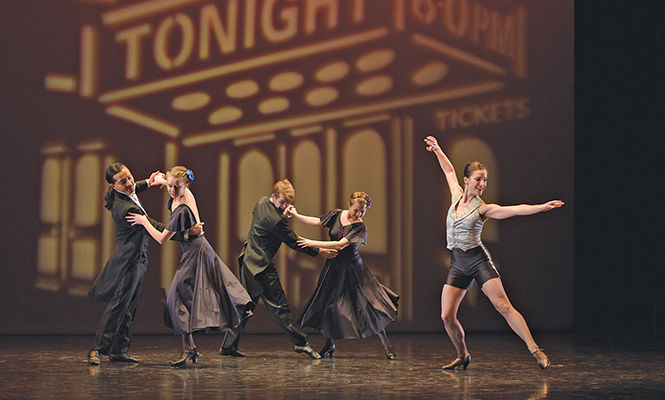Connect Four
Quadruple Bill kicks off Repertory Dance Theatre's "season of connection."
By Scott Renshaw @scottrenshawRepertory Dance Theatre is promoting its 2022-2023 season as "a season of connection." That notion takes on a variety of different meanings—including a season-opening program that re-connects the company with one of its most illustrious alumni.
Quadruple Bill (plus) showcases four works from celebrated choreographer Bill Evans, a native of Lehi, Utah who studied ballet under Ballet West founder William Christensen, took his career to New York in the 1960s, then returned to join RDT from 1967-1974. Though he currently lives in the Pacific Northwest, RDT artistic director Linda C. Smith hesitates to describe him as "retired." "This is a person who will never retire," she says with a laugh. "He's as active today as he's ever been."
"Bill has of course been an RDT asset, let's say, over the years," Smith adds. "We try to connect with him periodically, choreographically. It was very timely, I think, after COVID ... to touch base with our community of friends and artistic associates, and revitalize those important relationships."
When it came time to select the Evans pieces that would be featured in this program, the process was a collaboration between the choreographer and the company. "Some pieces, the dancers say, 'Oh, we'd love to do this or that,'" Smith says. "Some [Evans] mentioned, and I said, 'Eh, maybe another time.' He's created over 200 pieces, so there's a lot to choose from."
Ultimately, a quartet of Evans works became part of the Quadruple Bill program, spanning 50 years of his career. Hard Times, from 1973, evokes images of rural America during the Great Depression, set to traditional folk music. Suite Benny—originally staged in 1988, and reimagined in 2017—offers a tribute to the Big Band era of artists like Benny Goodman, which offered entertainment emerging from the Depression. Crippled Up Blues ... and other tales of Deseret (2015), originally created for RDT's 50th anniversary, features the music of Southern Utah-based musicians 3hattrio and touches on the history of the West. And Petroglyph offers a new interpretation of Evans' 1996 work Naturescape Unfolding.
The latter provides only the most recent example of the way a piece of choreography can forever be a work in progress. While the original version was inspired by the unique landscape of Utah, Evans felt inspired to take it in a new direction, to the extent that he's referring to Petroglyph as a world premiere.
"[Evans] said, 'I think that has a different meaning for me now, and I'll revive it with some edits,'" Smith recalls. "It already related to the natural world of Utah landscapes. But when he revisited it, he had been more fascinated with the petroglyphs that we have an abundance of; that kind of piqued his imagination."
Additionally, it's always the case that the simple process of working on an existing piece with new performers can affect its nature. Evans himself has been working with the dancers for several weeks, discovering the way a new iteration might look. "Bill has a very keen vision of what he did in the past, and how he wants to use that on a new cast," Smith says. "Sometimes the cast members will inspire you to do some aspect of it a little differently. There are always opportunities to adapt or make changes.
"You know with an artist, they're rarely 'finished' with it," she adds. "You have to grab the paintbrush out of their hands and say, 'It's finished, I'm buying it.'"
Petroglyph is only one part of the program, of course, and that aforementioned process of deciding on all the included pieces demonstrates a general philosophy towards building an evening of dance for an audience. "You go to the theater, and it should be nourishing, like a good meal," Smith says. "It needs to have a progression: an hors d'oeuvre, a salad, an entrée and a little dessert. I like to think of a program like that, that it carries you somewhere."
And a focus on the audience experience touches on another component of that "season of connection": the idea of re-connecting with live audiences. While RDT did perform live shows last season, in addition to continuing with virtual options, Smith says the company wants to really focus on what it means to bring audiences back into live performance, including the decision to offer both masks-required and masks-optional performances for this production.
"We are so delighted to have live audiences back," Smith says. "Yes, we are creating video opportunities now; even though seeing a video of a dance work is different, it still can be a wonderful experience. But there's nothing like dancing for an audience in a theater. They give you energy, and vice-versa.
"The last couple of years have been challenging, but they've offered some opportunities for us to kind of re-imagine ourselves, and new ways to serve and connect with an audience. It's been bittersweet, challenging, yet I think we've grown in our understanding about how to connect with people in a variety of ways."
More by Scott Renshaw
-
Film Reviews: New Releases for April 19
The Ministry of Ungentlemanly Warfare, Abigail, The Beast, Hard Miles, Sasquatch Sunset and more
- Apr 19, 2024
-
Faces of Salt Lake County book and portrait reception
Images and personal stories in a new book reveal local demographic diversity
- Apr 17, 2024
-
Feature film review: THE BEAST
A filmmaker's compelling ideas get a bit tangled in references to his creative influences.
- Apr 17, 2024
- More »
Latest in Arts & Entertainment
Readers also liked…
-
New TV for January 2023
Mayfair Witches, Velma, The Last of Us, Poker Face and more premieres
- Jan 4, 2023




